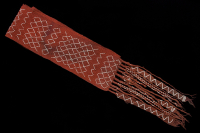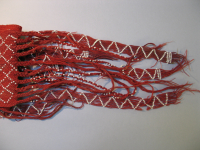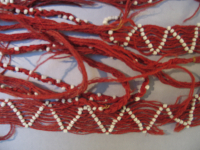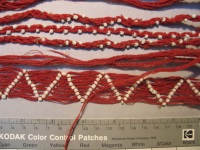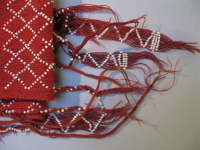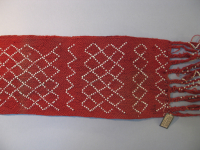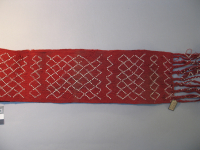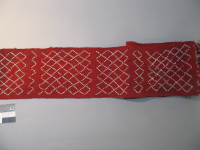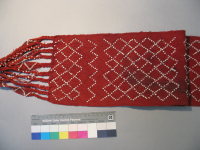sash
sash
sash
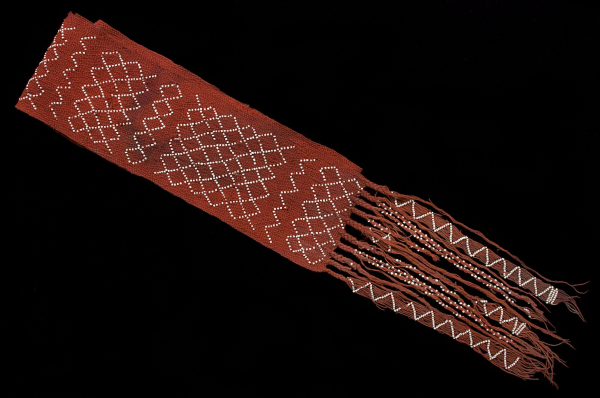


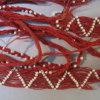

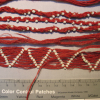
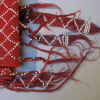

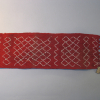
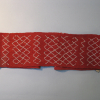
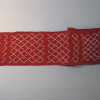

A red-woolen fingerwoven sash or scarf ornamented with diamond and zig-zag patterns in white pony beads. Great Lakes region, Anishinaabe, Hodenosaunee, or Métis, made in the mid- to late eighteenth century. Transferred to the Pitt Rivers Museum from the South Kensington Museum in 1884.
Beaded and fingerwoven sashes of this sort are common to the Great Lakes region. The Pitt Rivers Museum Accession book entry states that this item is probably Iroquois, perhaps Seneca (written by HB Burnham, Royal Ontario Museum, Toronto, October 1965).
Museum documentation and observations made by the GRASAC research team.
Read More About This Relative
wool, red-dyed; pony beads, white
Finger woven, decorated with beads woven into the sash and fringe. The sash threads are separated into several braids at both ends of the sash, before extending into a fringe. The fringe elements are woven into in three bands, each about an inch wide, in which white beads form zigzag patterns, staggered with five thinner strips. Several unusual techniques are found on these wide bands-- see photos.
Zigzag and diamond motifs. Moving from one side to the other: two rows of chained diamonds, a three-row panel of chained diamonds, zigzag , a five-row panel of chained diamonds, a single line of chained diamonds, a three-row panel of chained diamonds, a line of zigzag, a five-row panel of chained diamonds, a single line of chained diamonds, three-row panel of chained diamonds, altrenating between closed and open chains of diamonds, a five-row panel of chained diamonds, a line of zigzags, a three-row panel of diamonds, and a single line of chained diamonds.
Possibly horned serpent motifs - the design appears to open at ends into horn-like projections (RP).
The white pony beads suggest a date of manufacture between 1750-1790.
Provenance
Part of Pitt Rivers' founding collection. In 1884, the item was transferred to the Pitt Rivers Museum from the South Kensington Museum (later named the Victoria and Albert Museum). It was one of several items delievered to the South Kensington Museum in 1880, to be held until a permanent home was made for Pitt Rivers' collection in Oxford.
About This GRASAC Record
This record was created as part of a Great Lakes Research Alliance for the Study of Aboriginal Arts and Cultures (GRASAC) research trip to the Pitt Rivers Museum and British Museum, December 8-22 2007, funded by a grant from the International Opportunities fund of the Social Sciences and Humanities Research Council (SSHRC).
researchers present: Heidi Bohaker (HB), Al Corbiere (AC), Stacey Loyer (SL), Janis Monture (JM), Laura Peers (LP), Ruth Phillips (RP), Anne De Stecher (AS), Cory Willmott (CW).
43.0703, -80.1184
Stylistic features.
 Knowledge Sharing Platform
Knowledge Sharing Platform

